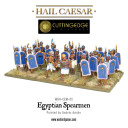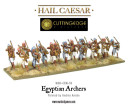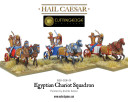Hail Caesar: Neue Ägypter
Warlord Games stellen drei Sets für die Ägypter vor.
Speerträger: 28,00 Pfund
The Egyptian pharaohs led their armies through Canaan and into Syria in a succession of wars throughout the age of the New Kingdom. Infantry formed the backbone of these forces, comprising archers and close fighters armed with spears, swords, and sometimes with heavy mace-like weapons. The Egyptian spear was not especially long, and was primarily a throwing weapon whose user would follow up with the deadly khopesh sickle-sword.
From the reign of Akhenaten (1379-1362BC) if not earlier, the Egyptian infantryman benefited from the addition of distinctive banded armour made from stiffened or reinforced fabric, images of warriors so equipped were discovered in the tomb of Tutankhamun.
The banded headcloth, so commonly associated with Egyptian infantry, is a typical feature of troops from the later Nineteenth dynasty, reflecting the appearance of the armies of such mighty warriors as Ramesses II and later pharaohs. It may conceal a helmet or could be a padded or plaited headdress – we don’t know for sure.
These troops carry a larger shield than that of earlier close-fighting infantry, more suitable for fighting in dense formations. Shields are shown painted in a solid colour such as red or blue, with a white border decorated with black, blue and red lines. Shields were often slung on the back, even in combat, and were used to form a palisade around the army’s encampment.
Bogenschützen: 22,00 Pfund
Archers were an important part of the Egyptian army, if not the most important part of all. The powerful composite bow, made from laminated strips of wood, was probably introduced by the Hyksos invaders prior to the New Kingdom, and was certainly in use by Egyptian troops from the time of Akhenaten (the Amarna period as it is often known). It was a very effective weapon that was said to be capable of shooting an arrow able to pierce a copper sheet three fingers thick.
Troops such as these fought in the campaigns of Ramesses II against the Hittites and their Canaanite allies, when the pharaoh engaged the Hittite King Muwatallis II in battle at Kadesh in 1274 BC. On that occasion they probably had little opportunity to use their deadly weapons, suddenly finding themselves ambushed by Hittite chariots emerging from concealed positions as they marched towards the Canaanite city.
These archers wear a form of laminated banded armour, probably made from stiffened cloth, and a frontal flap that covers the groin – probably also made from reinforced fabric. Their characteristic cloth headgear could be a form of padded armour, or plaited headdress, or it might be a simple cloth covering a helmet. In any case it afforded some protection for troops in the thick of battle.
Streitwägen: 32,00 Pfund
The Eighteenth, Nineteenth and Twentieth dynasties comprise the age of the Egyptian New Kingdom (1550-1077BC). During these years a succession of warrior pharaohs led Egyptian forces in wars of conquest, southwards to Nubia and northwards to Canaan, Amurru and Syria. At the forefront of the pharaohs’ armies were the most powerful weapons of the new age – chariots!
Egyptian chariots were lightly built, and were crewed by a driver and a fighter armed with a bow and a number of short spears, which could be thrown or used to stab at the enemy. Chariots were expensive to make, and were often elaborately decorated or gilded. After a battle, captured chariots were listed amongst the spoils of war.
During the New Kingdom Syria became a battleground for the empires of the age. Thuthmosis III (ruled 1479-1425 BC) campaigned against the cities of Canaan and Syria, and his many conquests have earned him the title of ‘Napoleon of Ancient Egypt’. At the Battle of Megiddo he fought against a coalition of Canaanites led by the King of Kadesh, winning the greatest victory of his reign. Afterwards the Hittites, Babylonians and Assyrians all acknowledged the pharaoh’s might with tributary gifts – only the Mitanni failed to do so – and Thuthmosis took his revenge by leading a campaign across the Euphrates and wreaking devastation upon the Mitannian King’s cities!
Die Modelle bestehen allesamt aus Metall.
Quelle: Warlord Games











die Figuren von Cutting Edge sind toll und eine Ägypter Armee will ich schon lange machen. Momentan bin ich mit Fire and Sword ausgelastet, aber irgendwann werde ich die Armee machen. Ich hoffe noch auf coole Charaktermodelle 😉
Kann man deine OiM-Sachen irgendwo sehen? 😉
Habe gestern meine neuen deutschen Söldner für die Schweden fertig bekommen.
Poste dann im Wargamer-Forum.
Ja, sowohl im TTWelt Forum und Sweetwater kann man meine Minis „bewundern“ 😀
Gleich mal gucken. 🙂
^^ Mir kommen beim ersten Bild sofort „Vorzeit“ Khemri Truppen in Kopf
Was haben die denn für komische Schilde im Schritt?
Ich vermute mal, dass das Stoffwickel darstellen sollen.
Mhh schöne Mini´s, passend zur Demo Mission im Hail Cesar Regelbuch. Hoffentlich schlagen da welche zu, bei uns werden aus der Epoche hauptsächlich die Griechen gespielt.
Wo bekommt man den Griechen für die Epoche her?
Hier wahrscheinlich 😀
http://otherworldminiatures.co.uk/shop/coming-soon/me4d-caveman-warband-7/
Aber im ernst, die Troja Kriege kann man so ungefähr in die Zeit packen, da gibt es schöne Figuren von Redoubt:
http://www.redoubtenterprises.com/shop/?page=shop/browse&category_id=61bfef34c129536358f147a7c65905bc
Die typischen Hopliten erblicken natürlich erst in ein paar hundert Jahren das Licht der Welt.
Es kann einfach nicht wahr sein… gestern hab ich auf ebay Chariot Wars für WAB gekauft – nicht aus einem speziellen Grund, sondern nur, um die Sammlung weiter auszubauen, denn die Bücher bekommt man ja immer schlechter.
Und jetzt kommen die mit sowas um die Ecke! AAAAAH!
Na ja so plötzlich kommen die ja auch nicht 😉 Deren Hethiter sehe ja auch ganz reizend aus 😉
Ahhh… das ist ja gut zu wissen 😉
Willkommen in der Region!
Mensch Leute, das ist schon etwas traurig 😉
Also nein, die alten Ägypter haben ihren Stil nicht von GW abgeguckt 😉
Das neue ägyptische Königreich hatte hunderte von Jahren vor dem antiken Griechenland Bestand. Und das Ding, was denen si vor den persönlichen Juwelen so baumelt ist in der Tat ein Schutzschild aus schwerer Kleidung, um eben jene Juwelen zu schützen 😉
Kollege im Club hat sich gerade Hetiter zugelegt, die Verlockung ist groß… ohweh
Na ich weiß ja nicht… Sie ziehen halb nackt in die Schlacht, aber die stelle panzern sie dann doch… Hab ich bisher noch nie gesehen bei irgendeiner darstellung.
Nur weil du das noch nicht gesehen hast, negiert das die geschichtlichen Fakten nicht. 😉
Die Preise sind ganz schön hoch….. ist ja schon GW-Niveau
saftiger preis für so ne durchschnittliche qualität